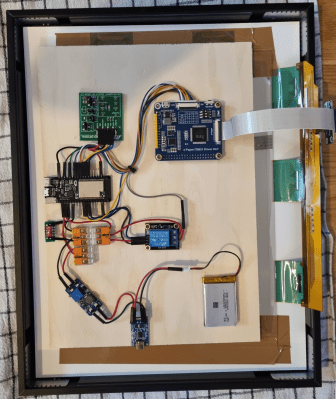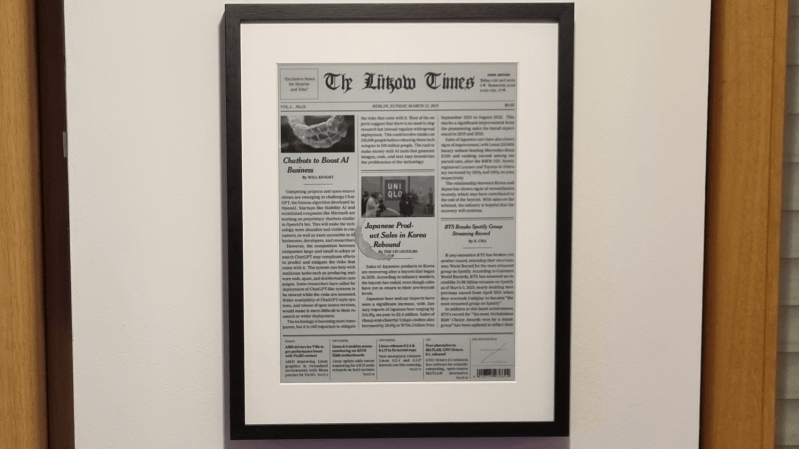E-Ink displays are becoming more ubiquitous and with their low power draw, high contrast and hackability, we see many projects use them in framed wall art, informational readouts and newspaper displays. [Sho] uses this idea to create a wall mounted newspaper packed full of features.

[Sho] describes using a 13.3 inch ED133UT2 1600×1200 E-Ink display with an ITE IT8951 electronic paper display (EPD) driver, controlled by an ESP32. An RV-3028-C7 real time clock (RTC) is used to keep time and to wake up the ESP32 and other devices for daily refreshes. A 3.7V 1100mAh LiPo battery provides power through an MT3608 boost converter module to provide the 5V needed, with the E-Ink display driver further isolated from the power behind a KY-019 5V relay module to avoid unnecessary power draw when not needed.
The backend software uses the OpenWeatherMap API to get daily weather reports and scrapes news websites which are then fed through an OpenAI ChatGPT API to provide summaries. [Sho] reports that text is formatted using a combination of LuaTeX, Ghostscript, ImageMagick and other scripts to format the eventual displayed graphics, including newspaper texture and randomely placed coffee stain effects.
Be sure to check out [Sho]’s project page for some more details. E-Ink displays are still a bit pricey but the effect is hard to beat and they make great options for projects like infinite generative landscapes or low power weather stations.
















I’m hoping these large displays get much cheaper soon. I’ve seen them used in shops so hopefully it will be like when shops adopted small ones for price tags.
Imagine incorporating into floor tiles with changeable patterns.
Customer: “Where can I find this item?”
Floor: “Follow me!” then shows arrows in the tiles pointing the way.
Actually it’ll probably display a 30 seconds ad of unrelated product before providing direction
I want to buy one!
You can. Have a look here: https://framelabs.eu.
For a “no-soldering” solution this is very neat. however if one is wiling to do some minimal soldering then you can make an extremely long running device by just doing away with the boost converter and the voltage regulator on the esp module and just using a LIFePo battery. A LIFePo has a useful voltage range that matches what the esp32 will run at without issue. Runtime is months (ie. it crashes because of a bug) to years.
Source: I made one of those if a bit smaller (weather, garbage collection days and nextcloud calender integration)